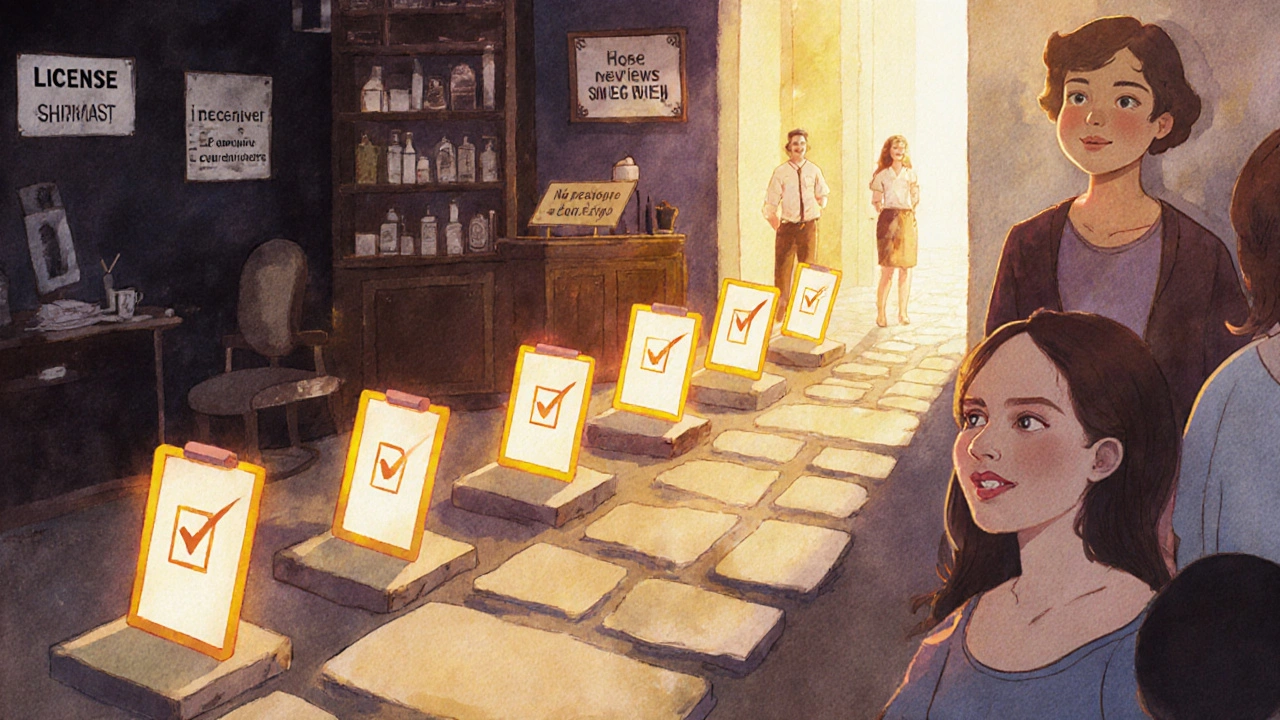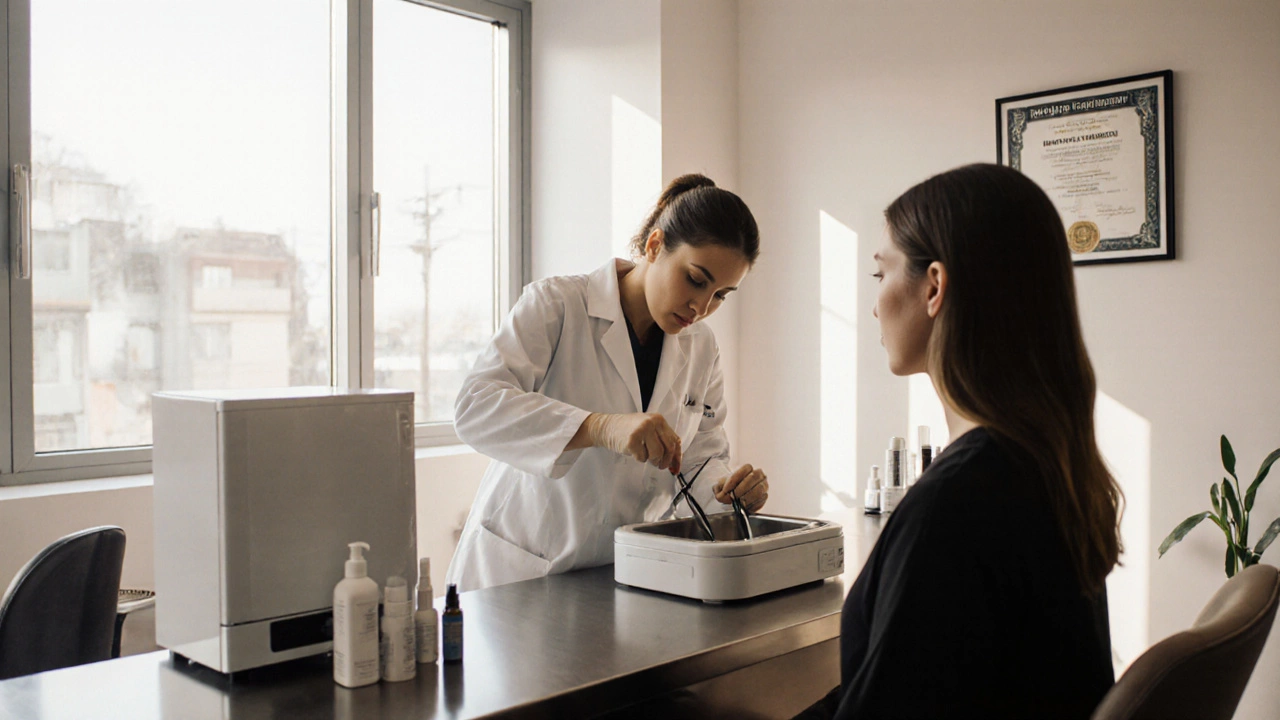Walking into the wrong beauty salon can cost you more than money-it can cost you time, trust, and even your skin. You’ve seen the ads: "Luxury treatments," "Expert stylists," "Best in town." But how do you know which one actually delivers? Too many people pick a salon based on a pretty Instagram post or a friend’s offhand recommendation. That’s not enough. Choosing a good beauty salon isn’t about vibes-it’s about facts.
Check Their Licensing and Certifications
A legitimate beauty salon in the U.S. must be licensed by the state board of cosmetology. This isn’t optional. If they don’t display their license visibly-usually near the front desk or in the treatment room-walk out. Same goes for technicians. A licensed esthetician, barber, or nail technician has passed a state exam, completed at least 1,000 hours of training, and understands sanitation laws. Unlicensed staff can cause infections, scarring, or allergic reactions. In 2024, the CDC reported over 1,200 cases of salon-acquired skin infections linked to unsterilized tools. Don’t be a statistic.Look at Their Sanitation Practices
Cleanliness isn’t just about a tidy space. It’s about how they handle tools. Watch how they sterilize instruments. Single-use items like tweezers, razors, and nail files should be opened in front of you. Reusable tools like clippers, scissors, and waxing spatulas must be washed, disinfected, and then autoclaved-a high-heat sterilization process. If you see them wiping tools with a damp cloth and calling it good, that’s a red flag. Ask to see their disinfection log. Reputable salons keep records of when each tool was sterilized. If they hesitate or can’t show you, they’re cutting corners.Read Real Reviews, Not Just Star Ratings
Five-star reviews on Google or Yelp don’t tell the whole story. Look for reviews that mention specifics: "The esthetician noticed my rosacea and adjusted the peel," or "They didn’t push me to buy expensive products." Avoid places with 500 reviews that all say "Amazing!" with no detail. Real reviews include before-and-after results, wait times, and how the staff handled concerns. Check reviews from the last six months. A salon that was great in 2022 might have lost its standards by now. Also, look for reviews from people with your skin type or hair texture. If you have curly hair and all the glowing reviews are from straight-haired clients, that’s a clue.Ask About Their Products
A good salon doesn’t just use any product-it uses professional-grade lines that are backed by science. Brands like SkinCeuticals, Dr. Dennis Gross, or Dermalogica are common in reputable salons. These products are formulated for clinical results, not just marketing. If they’re using cheap, drugstore brands or can’t name what they’re applying, that’s a problem. Ask: "What ingredients are in this treatment?" If they say, "It’s just our signature blend," that’s a sign they don’t know-or don’t want you to know. Professionals can explain active ingredients like retinol, hyaluronic acid, or salicylic acid and why they’re used for your specific concern.
Watch How They Handle Consultations
A good salon doesn’t rush you into a service. They start with a consultation. This should take at least 10-15 minutes. They should ask about your skin history, allergies, medications, and goals. If you mention you’re pregnant and they immediately offer a chemical peel without hesitation, walk away. A professional will pause, research safe alternatives, or refer you to a dermatologist. They should never pressure you into a package deal on your first visit. If they say, "This $800 facial package is only available today," they’re more interested in your wallet than your skin.Pay Attention to the Staff’s Attitude
The best technicians aren’t just skilled-they’re observant. They notice if you flinch during a wax, if your skin is red after a cleanse, or if you’re uncomfortable with a certain product. They adjust on the spot. If the staff seems bored, distracted, or dismissive of your questions, that’s a sign they don’t care about your experience. Good salons train their staff to listen, not just perform. You should feel like a patient, not a transaction.Compare Pricing-But Don’t Chase the Lowest
Prices vary by city, service, and expertise. A facial in New York will cost more than one in Kansas City. But if a salon offers a full-body wax for $15 while others charge $50, something’s off. Low prices often mean low-quality products, undertrained staff, or unsafe practices. On the flip side, the most expensive salon isn’t always the best. Look for mid-range pricing that matches the services described. A good salon will give you a clear breakdown: $75 for a facial, $40 for brow shaping, no hidden fees. If they won’t quote prices upfront, they’re hiding something.
Trust Your Gut After the First Visit
After your first appointment, ask yourself: Did I feel respected? Did they explain what they did? Did my skin or hair look better, not just different? Did they follow up with aftercare advice? If you left feeling confused, rushed, or like you were sold something you didn’t need, it’s not the right place. The best salons don’t just fix problems-they educate you. They tell you what to avoid, what to use at home, and when to come back. That’s the mark of professionalism.What to Do If You’ve Already Been to a Bad Salon
If you’ve had a bad experience-redness that won’t fade, a rash, hair breakage, or a botched eyebrow-you need to act fast. Stop going there. Document everything: take photos, save receipts, write down what was done and by whom. Contact the salon manager and ask for a written apology or refund. If they refuse or ignore you, file a complaint with your state’s cosmetology board. Most states have online portals for reporting unprofessional or unsafe practices. Don’t wait until it gets worse. Your skin and hair deserve better.Final Checklist: Before You Book
- ✅ License displayed? (State cosmetology board)
- ✅ Tools sterilized in front of you? (Autoclave or single-use only)
- ✅ Staff asks about your skin/hair history?
- ✅ They name the products they use?
- ✅ No pressure to buy packages on first visit?
- ✅ Reviews mention real results, not just "great service"?
- ✅ You feel comfortable asking questions?
If you can answer yes to all seven, you’ve found a good one. If even one is no, keep looking. A beauty salon isn’t a luxury-it’s a health service. Treat it like one.
How do I know if a beauty salon is licensed?
All licensed beauty salons must display their state-issued cosmetology license in a visible spot, usually near the front desk or in the treatment room. You can also verify the license online through your state’s cosmetology board website by searching the salon’s name or license number. If they refuse to show it or can’t provide the number, don’t go there.
Can I bring my own tools to a beauty salon?
Yes, you can bring your own tools, and many professionals appreciate it-especially if you have sensitive skin or allergies. But don’t assume they’ll use them. Always ask first. Some salons have policies against outside tools due to liability or insurance rules. If they say no, ask why. If they say it’s for hygiene, that’s valid. If they say it’s because they want you to buy their products, that’s a red flag.
What should I avoid saying during a consultation?
Avoid saying things like, "I don’t know what I want," or "Just do whatever you think is best." That puts the burden on the technician and opens the door to upselling or inappropriate treatments. Instead, say, "I want to improve my acne scars," or "I’ve been getting breakouts since I started this new skincare routine." Be specific about your goals and concerns. The better you communicate, the better the result.
How often should I visit a beauty salon for maintenance?
It depends on the service. For facials, every 4-6 weeks aligns with your skin’s renewal cycle. Waxing is usually every 3-5 weeks, depending on hair growth. Haircuts vary: short styles need trimming every 4-6 weeks, long styles every 8-12. But don’t stick to a schedule just because it’s convenient. Go when your skin or hair shows signs of needing attention-oiliness, breakouts, split ends, or dullness. A good salon will help you figure out your personal rhythm, not push you into a fixed plan.
Are organic or natural salons better?
Not necessarily. "Organic" and "natural" are marketing terms with no legal definition in most states. A salon can call itself organic even if it uses 5% plant-based ingredients. What matters is whether the products are safe, effective, and suited to your skin. Some natural ingredients can be just as irritating as synthetics-like essential oils or citrus extracts. Ask for ingredient lists and check for known allergens. The best salon uses science-backed products, whether they’re labeled organic or not.
What if I’m not happy with the result?
Speak up immediately. Most good salons will offer a free fix if something went wrong-especially if it was their mistake. Don’t wait days or weeks. Contact them within 24-48 hours. If they refuse to help or blame you, that’s a sign they’re not confident in their work. Walk away and consider filing a complaint with your state board. Your satisfaction is their responsibility.

